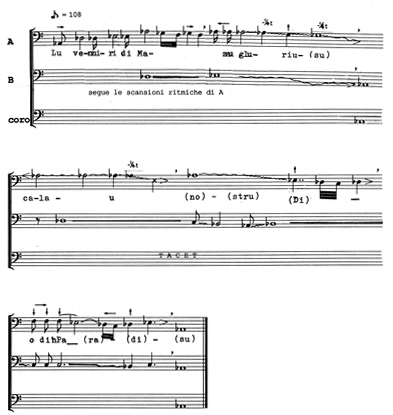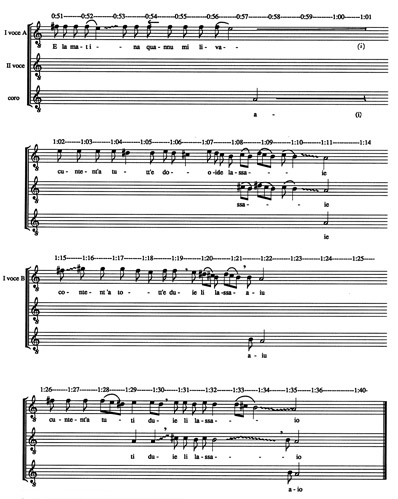|
A large repertoire of traditional songs having a multivocal structure was part of a spontaneous ritual itinerary of penitence -- referred to as 'a Cerca --which took place at Tusa on the nights of Holy Thursday and Good Friday until 10 or 15 years ago. The leading actors were groups of singers who, moving from church to church, would sing the razzioni (religious narratives) before the Sepulchres, stories that told of Christ’s Calvary and the joy of the Holy Saturday. The rapid decay in the socio-cultural context that the ritual was related to has, in just a few years, limited the places dedicated to acts of devotion, and a few years ago, when the survey was carried out, only one group of singers was still performing. At the same time, the para-liturgical ceremonies controlled by the confraternities (there are six in particular, those of San Giuseppe, San Giuliano, San Giovanni, San Nicola, Santa Caterina and of Christ our Lord), included the performance of several devotional songs (Orfanu figghiu malasurtatu, Salvi Rriggina, Lu Venniri di mazzu and Lu Sabitu matinu). The space dedicated to expressing popular devotion, however, remained Good Friday, when several groups of singers along the procession, which still sees Christ in the urn and Our Lady of Sorrows carried around in the procession through the village streets, would chant with several voices, apart from the cited dialect texts, Latin texts such as the Miserere and the Stabat Mater. From the musical standpoint, the songs of Tusa, even before being studied for their structural components, stand out for their general acoustic effect, both for the use of the voice that recalls the banniate (the cries) of the street vendors, and for the frequent recourse to glissati among the sounds or the adoption of a non-tempered tuning, or the unusual interval relations that are created between the different voices. All of these features make the repertoire of Tusa virtually unique in the Sicilian ethno-musical scenario. They are present both in the sacred repertoire and in the profane one. The two pieces I will analyse - Lu Venniri di mazzu and E la matina quannu mi livai - indeed belong to the two repertoires, the first being a Holy Week song, while the second is a lyrical song performed outside the institutional occasions for singing at functions. They develop along the lines of a three-part polyphonic structure, not exactly 'ad accordo', but actually based on unorthodox relations between the parallel voices that unequivocally stray away in the melodic lines of the equal tempered tuning. For this reason the transcriptions that we have tried to make of the pieces of this repertoire are extremely approximate as regards the sound pitch, but they nevertheless show the formal structure of the song and the melodic profile of the trend.
has, compared with the first, a prevalent trend for the 4th parallel. The latter characteristic, however, might be explained in the light of the fact that we do not come across an acute voice in this musical corpus, which is a unique case as compared with the repertoire of the surrounding territories. This aspect may depend on the practice of transportation of a previously upper voice to the lower octave, made necessary in the past by the shortage of contralto voices. The chorus performs a single note, limiting itself to 'accordare', reinforcing in unison the finale. The melodic line is performed in a scope of 5th making great use of the glissato to reach the close sounds or even at the moment of the end of the phrase before taking a breath.
This piece uses a six-tone scale (except for the appearance of a seventh, G sharp, not exactly in tune and not used otherwise), which are always presented in a descending succession. The melodic succession always tends towards reaching the finale (A) that is also the note on which the chorus ‘accorda’. All of the sounds used are removed from those of the equal tempered scale and do not, as compared with them, uniformly fall or rise, except the A, whose frequency is about 440Hz. The scale model, rather than reminding us of the tonal procedures, suggests affinities with the Lydian mode transported a third above (i.e., diatonic major with a sharpened fourth, tonic=A). The verbal text is organised into couplets of hendecasyllables that sustain the first musical phrase, divided into two semi-phrases. The second musical phrase uses the double repetition of the second verse. The performance structure provides for the presence of a solo voice that utters the whole text. A second voice intervenes at the end of the two phrases at a distance of a third from the first. The chorus has the role of emphasising the finale when it is reached, doubling it, or accordando at the end of the first semi-phrase, when, always performing the same sound (A), it is at an approximate distance of fifth from the melody. |

